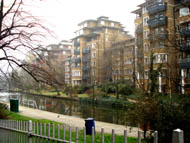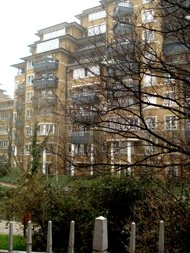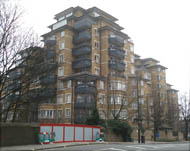London
Lock Hospital
and Rescue Home
and Rescue Home
283 and 283A Harrow Road, Paddington, W2
Medical
dates:
Medical
character:
Specialist
The first Lock Hospital was
built in Southwark during the 12th century; it specialised in treating
leprosy. The name 'Lock' was derived from the rags or locks (Old
Fr. loques) that covered the
patients' sores.
Leprosy had virtually disappeared in England by the 15th century and the lazar (leper) hospitals became redundant. Some hospital became derelict while others were used for new purposes. Some lazar hospitals began to treat venereal disease. The Southwark Lock Hospital closed in 1760, but the name lived on in the London Lock Hospital until the mid 20th century.
The first specialist voluntary hospital of any kind to be established in London, it opened in 1747 for the treatment of venereal disease. The London Lock Hospital was founded by William Bromfield in a purpose-built building in Grosvenor Place, near Hyde Park Corner. It was immensely popular, although the treatments then available were ineffective. It was the Hospital's policy then never to readmit a patient once discharged.
The Lock Asylum for the Reception of Penitent Female Patients, which had been proposed in 1787, finally opened in 1792 as a refuge for women who had received treatment at the Hospital but had no steady life to return to; they were taught needlework and other skills in the hope that they could be employed in service. Originally located at 5-6 Osnaburg Row, the Asylum moved to a building opposite the Cannon Brewery in Knightsbridge in 1812, then to Lower Eaton Street in 1816.
In 1842 the Hospital moved to a 4 acre site in Harrow Road bought from the Great Western Railway Co. Additional wings for the Lock Asylum opened in 1849, so that the 'fallen' inmates could be nearer to the Chapel.
In 1862 a new branch opened at 91 Dean Street for male out-patients. The Harrow building was renamed the 'Female Hospital'.
An east wing was added in 1867; the main block was also heightened.
By 1890 there were 140 beds for women. The Asylum had 40 beds. In 1893 the Hospital and Asylum were renamed the London Lock Hospital and Rescue Home.
A Nurses' Home was added to the east wing in 1909. In 1917 a maternity unit was opened and, at the request of the LCC, a special unit for mentally defective women with venereal disease. An ophthalmology department and an electrotherapy unit were established as well as a genitourinary unit, which treated both venereal and non-venereal disorders.
By 1932 the number of beds had been reduced. In 1938 a new maternity centre opened next door at No. 283A.
During WW2 it became a Military Isolation Hospital.
In 1948 the Hospital joined the NHS and became the Out-Patients Department of Paddington Hospital.
It closed in 1952. The Chapel and west wing were demolished soon after, but the surviving buildings were used for offices and record storage by the St Charles Group until 1968, when they became vacant.
Leprosy had virtually disappeared in England by the 15th century and the lazar (leper) hospitals became redundant. Some hospital became derelict while others were used for new purposes. Some lazar hospitals began to treat venereal disease. The Southwark Lock Hospital closed in 1760, but the name lived on in the London Lock Hospital until the mid 20th century.
The first specialist voluntary hospital of any kind to be established in London, it opened in 1747 for the treatment of venereal disease. The London Lock Hospital was founded by William Bromfield in a purpose-built building in Grosvenor Place, near Hyde Park Corner. It was immensely popular, although the treatments then available were ineffective. It was the Hospital's policy then never to readmit a patient once discharged.
The Lock Asylum for the Reception of Penitent Female Patients, which had been proposed in 1787, finally opened in 1792 as a refuge for women who had received treatment at the Hospital but had no steady life to return to; they were taught needlework and other skills in the hope that they could be employed in service. Originally located at 5-6 Osnaburg Row, the Asylum moved to a building opposite the Cannon Brewery in Knightsbridge in 1812, then to Lower Eaton Street in 1816.
In 1842 the Hospital moved to a 4 acre site in Harrow Road bought from the Great Western Railway Co. Additional wings for the Lock Asylum opened in 1849, so that the 'fallen' inmates could be nearer to the Chapel.
In 1862 a new branch opened at 91 Dean Street for male out-patients. The Harrow building was renamed the 'Female Hospital'.
An east wing was added in 1867; the main block was also heightened.
By 1890 there were 140 beds for women. The Asylum had 40 beds. In 1893 the Hospital and Asylum were renamed the London Lock Hospital and Rescue Home.
A Nurses' Home was added to the east wing in 1909. In 1917 a maternity unit was opened and, at the request of the LCC, a special unit for mentally defective women with venereal disease. An ophthalmology department and an electrotherapy unit were established as well as a genitourinary unit, which treated both venereal and non-venereal disorders.
By 1932 the number of beds had been reduced. In 1938 a new maternity centre opened next door at No. 283A.
During WW2 it became a Military Isolation Hospital.
In 1948 the Hospital joined the NHS and became the Out-Patients Department of Paddington Hospital.
It closed in 1952. The Chapel and west wing were demolished soon after, but the surviving buildings were used for offices and record storage by the St Charles Group until 1968, when they became vacant.
Present status (February 2008)
The site has been redeveloped into housing.

The Hospital was built on land adjacent to and north of the Grand Junction Canal and east of the Paddington workhouse (above and below).


Looking along Harrow Road
The Royal Free Hospital School of
Medicine currently offers an annual prize to its students - The London Lock
Hospital Memorial Prize in Sexually Transmitted Diseases. The Prize was founded in 1965
through a bequest of an old student and part-time member of staff, Miss
Gladys Sandes.
(Author unstated) 1952 End of the London Lock Hospital. British Medical Journal 2 (4787), 768.
Black N 2006 Walking London's Medical History. London, Royal Society of Medicine Press.
Merions LE (ed) 1997 The Secret Malady: Veneral Disease in 18th Century Britain and France. Lexington, Univerity Press of Kentucky.
Williams DI 1995 The London Lock - a Charitable Hospital for Venereal Disease 1746-1952. London, Royal Society of Medicine Press.
http://en.wikipedia.org
http://enlightenedage.blogspot.co.uk
http://georginaduschessofdevonshire.blogspot.co.uk
https://patriciahysell.wordpress.com
www.aim25.ac.uk
www.australiandoctor.com.au
www.lookandlearn.com
Return to home page